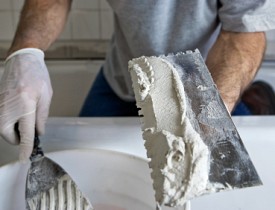Polyblend Grout
 Polyblend grout is today's standard for cement-based tile grout. The "poly" is short for polymer-modified and indicates that the grout mix includes latex-polymer additives for improved water-resistance and adhesion. Polyblend is also the proprietary name for one of the leading brands of polymer-modified grouts. Similar products may be labeled as "latex" or "latex-modified."
Polyblend grout is today's standard for cement-based tile grout. The "poly" is short for polymer-modified and indicates that the grout mix includes latex-polymer additives for improved water-resistance and adhesion. Polyblend is also the proprietary name for one of the leading brands of polymer-modified grouts. Similar products may be labeled as "latex" or "latex-modified."
A User-Friendly Grout
The majority of polyblend grouts come in a dry powder that you mix with water prior to application. They are suitable for most tile applications and clean up with water -- before they set, that is. As a cement-based mix, polyblend grout is easier to work with than epoxy grout, and because the recommended additives are already in the mix, you don't have to add liquid latex modifiers when mixing the grout, as you do with traditional grout formulations.
Types of Polyblend Grout
Polyblend grout comes in two basic types: sanded and non-sanded. Use sanded grout for grout joints that are 1/8-inch wide and wider. The sand helps resist cracking with wider joints. For joints smaller than 1/8-inch, use non-sanded grout. Manufacturers typically offer both sanded and non-sanded grouts in their full range of premixed colors.
Mixing Polyblend Grout
A proper mix is critical to the workability and long-term strength of polyblend grouts. Follow the manufacturer's instructions to the letter. As a general rule, mix grout in small batches (as much as you can apply in about half the working time of the product), using a small, clean bucket and a margin trowel (pros mix grout in larger quantities, using a drill and paddle mixer). Add the powder to the bucket first, then add about 3/4 of the recommended amount of water, and mix. Add more water in small increments, as needed, to achieve the desired consistency.
Polyblend Grout Application, Cleanup and Sealing
As with mixing, follow the manufacturer's instructions carefully when applying and cleaning up the grout. Most polyblends are applied with standard grouting tools: rubber grout float, grout sponge and a bucket for rinse water. Be sure to use a grout sponge with tight cells and rounded edges to prevent pulling the grout from the joints as you wipe across the tile. Seal polyblend grout 72 hours after application.
Where to Buy Polyblend Grout
Polyblend grouts are available anywhere tile supplies are sold. Large home centers and local tile suppliers are likely to have the best selection of products. Ask your tile supplier or retailer for a full sample card of the available colors, or visit a manufacturer's website. To ensure an accurate color match for any future repairs or changes, buy at least 10% more grout than you need, and save the extra in a sealed plastic bag stored in a dry area.
Polyblend grout is great, whether you undertake a DIY tiling project or hire a tile expert to handle the job for you.
Updated April 12, 2018.
Related Articles
Looking for a Pro? Call us (866) 441-6648

Tile Contractors Experiences

Tile Installation For New Kitchen Backsplash And Guest Bathroom Floor

Beautiful Tile Backsplash Completes Our Kitchen Remodel



